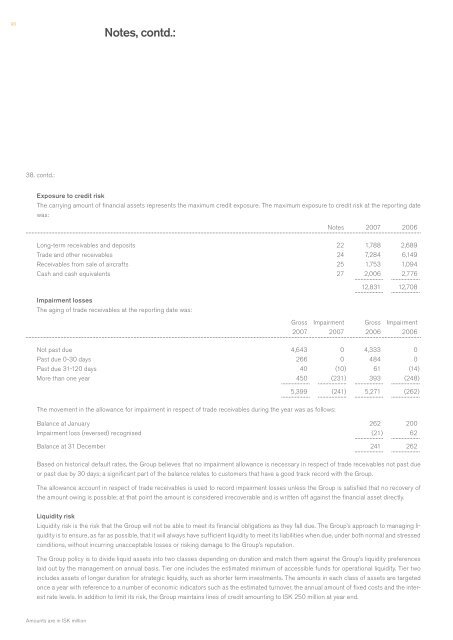Icelandair Group Annual Report 2007
Icelandair Group Annual Report 2007
Icelandair Group Annual Report 2007
You also want an ePaper? Increase the reach of your titles
YUMPU automatically turns print PDFs into web optimized ePapers that Google loves.
96<br />
Notes, contd.:<br />
38. contd.:<br />
Exposure to credit risk<br />
The carrying amount of financial assets represents the maximum credit exposure. The maximum exposure to credit risk at the reporting date<br />
was:<br />
Notes <strong>2007</strong> 2006<br />
Long-term receivables and deposits 22 1,788 2,689<br />
Trade and other receivables 24 7,284 6,149<br />
Receivables from sale of aircrafts 25 1,753 1,094<br />
Cash and cash equivalents 27 2,006 2,776<br />
12,831 12,708<br />
Impairment losses<br />
The aging of trade receivables at the reporting date was:<br />
Gross Impairment Gross Impairment<br />
<strong>2007</strong> <strong>2007</strong> 2006 2006<br />
Not past due 4,643 0 4,333 0<br />
Past due 0-30 days 266 0 484 0<br />
Past due 31-120 days 40 (10 ) 61 (14 )<br />
More than one year 450 (231) 393 (248)<br />
5,399 (241 ) 5,271 (262)<br />
The movement in the allowance for impairment in respect of trade receivables during the year was as follows:<br />
Balance at January 262 200<br />
Impairment loss (reversed) recognised (21) 62<br />
Balance at 31 December 241 262<br />
Based on historical default rates, the <strong>Group</strong> believes that no impairment allowance is necessary in respect of trade receivables not past due<br />
or past due by 30 days; a significant part of the balance relates to customers that have a good track record with the <strong>Group</strong>.<br />
The allowance account in respect of trade receivables is used to record impairment losses unless the <strong>Group</strong> is satisfied that no recovery of<br />
the amount owing is possible; at that point the amount is considered irrecoverable and is written off against the financial asset directly.<br />
Liquidity risk<br />
Liquidity risk is the risk that the <strong>Group</strong> will not be able to meet its financial obligations as they fall due. The <strong>Group</strong>’s approach to managing liquidity<br />
is to ensure, as far as possible, that it will always have sufficient liquidity to meet its liabilities when due, under both normal and stressed<br />
conditions, without incurring unacceptable losses or risking damage to the <strong>Group</strong>’s reputation.<br />
The <strong>Group</strong> policy is to divide liquid assets into two classes depending on duration and match them against the <strong>Group</strong>’s liquidity preferences<br />
laid out by the management on annual basis. Tier one includes the estimated minimum of accessible funds for operational liquidity. Tier two<br />
includes assets of longer duration for strategic liquidity, such as shorter term investments. The amounts in each class of assets are targeted<br />
once a year with reference to a number of economic indicators such as the estimated turnover, the annual amount of fixed costs and the interest<br />
rate levels. In addition to limit its risk, the <strong>Group</strong> maintains lines of credit amounting to ISK 250 million at year end.<br />
Amounts are in ISK million

















